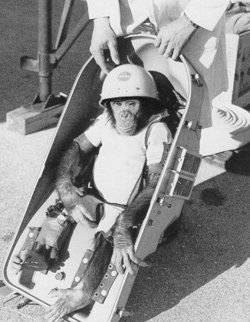Ham the Chimp
|
|
Ham, also known as Ham the Chimp and Ham the Astrochimp was the first higher primate launched into outer space by the United States.
In December 1960 the 44-month old chimpanzee was trained to do simple tasks in response to electric lights and sounds, with response being timed. On January 31, 1961, Ham was secured in a Project Mercury capsule labeled MR-2 and launched from Cape Canaveral, Florida into outer space. The capsule suffered a partial loss of pressure during the flight, but Ham's space suit prevented him from suffering any harm. During the flight Ham had to push a lever within five seconds of seeing a flashing blue light; as per pre-flight training, failure would result in an electric shock to the soles of his feet. Ham's performance in space was only a fraction of a second slower than on Earth, demonstrating that tasks could be performed in space. Ham's capsule splashed down in the Atlantic Ocean and was recovered by a rescue ship later that day.
After the flight Ham lived for 17 years in the National Zoo in Washington D.C., then in a zoo in North Carolina before dying at the age of 27 on January 19, 1983. Ham appeared repeatedly on television, and even on film with Evel Knievel. Ham the Chimp is buried at the International Space Hall of Fame in Alamogordo, New Mexico.
Ham's backup, Minnie was the only female chimp trained for the Mercury program. After her role in the Mercury program ended, Minnie became part of an Air Force chimp-breeding program, producing nine offspring and helping raise the offspring of several other members of the chimp colony. She was the last surviving astro-chimp. She died at age 41 on March 14, 1998. Minnie is buried next to Ham at the International Space Hall of Fame in Alamogordo, New Mexico.
See also
External links
- NASA Description of mission (http://www.hq.nasa.gov/office/pao/History/SP-4201/ch10-3.htm)
- Ham the Chimp (http://www.who2.com/hamthechimp.html)nl:Ham (astronaut)

